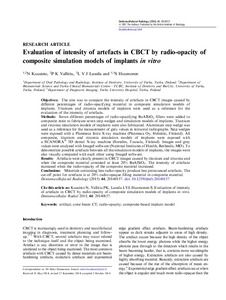Evaluation of intensity of artefacts in CBCT by radio-opacity of composite simulation models of implants in vitro
Kuusisto N; Vallittu PK; Lassila LV; Huumonen S
https://urn.fi/URN:NBN:fi-fe2021042715411
Tiivistelmä
Objectives: The aim was to compare the intensity of artefacts in CBCT images caused by different percentages of radio-opacifying material in composite simulation models of implants. Titanium and zirconia models of implants were used as a reference for the evaluation of the intensity of artefacts. Methods: Seven different percentages of radio-opacifying BaAlSiO2 fillers were added to composite resin to fabricate seven step wedges and simulation models of implants. Titanium and zirconia simulation models of implants were also fabricated. Aluminium step wedge was used as a reference for the measurement of grey values in intraoral radiographs. Step wedges were exposed with a Planmeca Intra X-ray machine (Planmeca Oy, Helsinki, Finland). All composite, titanium and zirconia simulation models of implants were exposed with a SCANORA® 3D dental X-ray machine (Soredex, Tuusula, Finland). Images and grey values were analysed with ImageJ software (National Institutes of Health, Bethesda, MD). To demonstrate possible artefacts between all the simulation models of implants, the images were also visually compared with each other using ImageJ software. Results: Artefacts were clearly present in CBCT images caused by titanium and zirconia and when the composite material consisted at least 20% BaAlSiO2. The intensity of artefacts increased when the radio-opacity of the composite material increased. Conclusions: Materials containing less radio-opacity produce less pronounced artefacts. The cut-off point for artefacts is at 20% radio-opaque filling material in composite material.
Kokoelmat
- Rinnakkaistallenteet [27094]
